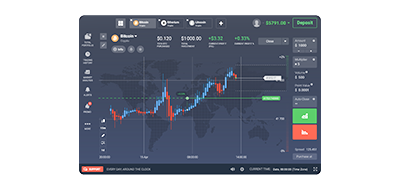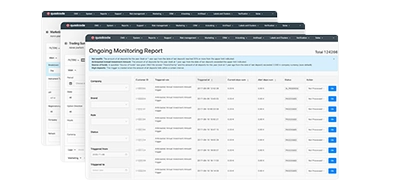กลับ
Contents
Binary Options คืออะไร?

Iva Kalatozishvili
Business Development Manager

Demetris Makrides
Senior Business Development Manager
ไบนารีออปชันคืออนุพันธ์ที่ให้เทรดเดอร์คาดการณ์และคาดเดาทิศทางการเคลื่อนไหวของราคาของสินทรัพย์ในช่วงระยะเวลาหนึ่ง คำว่า "ไบนารี" มาจากผลลัพธ์ของธุรกรรมที่เป็นไปได้สองประการ คือ คุณจะสูญเสียเงินหากการคาดการณ์ผิดพลาด และจะได้กำไรหากการคาดการณ์ถูกต้อง ความเรียบง่ายของออปชันขึ้นอยู่กับความรับผิดชอบเพียงอย่างเดียวของเทรดเดอร์ในการตัดสินใจว่ามูลค่าของสินทรัพย์อ้างอิง ไม่ว่าจะเป็นหุ้น สกุลเงิน หรือสินค้าโภคภัณฑ์ จะเพิ่มขึ้นหรือลดลงเมื่อถึงเวลาหมดอายุ
ไบนารีออปชั่นทำงานอย่างไร
การซื้อขายไบนารีออปชันนั้นตรงไปตรงมา แต่เทรดเดอร์ต้องอาศัยการวิเคราะห์ตลาดที่แม่นยำและทักษะการจับจังหวะที่แม่นยำ วิธีการเทรดออปชันนี้เกี่ยวข้องกับการเลือกสินทรัพย์อ้างอิงและคาดการณ์ว่าราคาของสินทรัพย์นั้นจะสูงกว่าหรือต่ำกว่าจุดที่กำหนดไว้ ซึ่งเรียกว่าราคาใช้สิทธิ์ในอนาคต กรอบเวลาหมดอายุสำหรับการคาดการณ์เหล่านี้อาจใช้เวลาตั้งแต่หนึ่งนาทีไปจนถึงหลายชั่วโมง หรืออาจยาวนานถึงหลายวัน
หากคุณคิดว่าหุ้นตัวหนึ่งจะขึ้นในชั่วโมงถัดไป และคุณซื้อออปชัน "คอล" และการคาดการณ์ของคุณถูกต้องเมื่อออปชันหมดอายุ คุณจะได้รับเงินจำนวนหนึ่ง โดยปกติแล้วจะอยู่ที่ประมาณ 70 ถึง 90 เปอร์เซ็นต์ของเงินลงทุนเริ่มต้น แต่หากราคาลดลงหรือไม่ถึงเป้าหมาย คุณจะสูญเสียเงินลงทุนสำหรับหุ้นตัวนั้น โครงสร้างพื้นฐานของการเทรดออปชัน — การเลือกระหว่างผลลัพธ์ที่เป็นไปได้เพียงสองแบบ — เป็นสิ่งที่มักจะดึงดูดเทรดเดอร์ อย่างไรก็ตาม สิ่งสำคัญคือต้องตระหนักถึงความเสี่ยงที่เพิ่มขึ้นที่เกี่ยวข้องกับธุรกรรมดังกล่าว
ประเภทของตัวเลือกไบนารี
ปัจจุบันมีไบนารีออปชันหลายประเภทพร้อมวิธีการคาดการณ์และระดับความเสี่ยงที่หลากหลายให้เลือกใช้ในตลาด หนึ่งในประเภทที่ได้รับความนิยมคือออปชันแบบ "คอลออปชัน" หรือ "พุตออปชัน" ซึ่งคุณจะวางเดิมพันว่าราคาของสินทรัพย์จะเพิ่มขึ้น (คอลออปชัน) หรือลดลง (พุตออปชัน) เมื่อเทียบกับราคาใช้สิทธิ์เมื่อถึงวันหมดอายุ นอกจากนี้ยังมีรูปแบบอื่นๆ ที่ใช้กัน ได้แก่:
- ตัวเลือกการสัมผัส/ไม่สัมผัส:ในสถานการณ์เหล่านี้ เทรดเดอร์จะคาดการณ์ว่าราคาสินทรัพย์จะถึงระดับ (แตะ) ก่อนกำหนดเส้นตายหรือไม่ เทรดเดอร์จะได้กำไรหากราคาแตะหรือหลีกเลี่ยงการแตะระดับที่กำหนดไว้ในกรอบเวลาที่กำหนด ตามที่คาดการณ์ไว้
- ตัวเลือกช่วง:เมื่อใช้ออปชันแบบ Range เทรดเดอร์จะคาดการณ์ว่ามูลค่าของสินทรัพย์จะคงอยู่ในช่วงที่กำหนดจนถึงเวลาหมดอายุ หรือจะทะลุผ่านขอบเขตของช่วงนั้นไปเลยก็ได้ จำนวนเงินที่ได้จะขึ้นอยู่กับว่าราคายังคงอยู่ในกรอบที่กำหนดหรือไม่
ตัวเลือกไบนารีประเภทต่างๆ เสนอวิธีต่างๆ ในการทำการซื้อขายและช่วยให้ผู้ซื้อขายสามารถปรับกลยุทธ์ของตนให้สอดคล้องกับสภาวะตลาดในขณะนั้นได้
ตัวเลือกไบนารี เทียบกับ CFD เทียบกับ Forex: อะไรคือความแตกต่าง
การรู้ถึงความแตกต่างระหว่าง ตัวเลือกไบนารี - CFDs - and Forex can really help you choose the right way to trade- based on what you're aiming for and how much risk you're comfortable with. Here's a quick look at how they stack up.
| คุณสมบัติ | ตัวเลือกไบนารี | CFDs | ฟอเร็กซ์ |
| โครงสร้างผลลัพธ์ | ตั้งค่าชนะ/แพ้ | กำไร/ขาดทุนสามารถเปลี่ยนแปลงได้ | กำไร/ขาดทุนสามารถเปลี่ยนแปลงได้ |
| เลเวอเรจ | ไม่มี | มักใช้เลเวอเรจสูง | มีเลเวอเรจสูง |
| เสี่ยง | สูง (ทั้งหมดหรือไม่มีเลย) | สูง | สูง |
| ระยะเวลา | นาทีถึงชั่วโมง | รายวันหรือยาวนานกว่านั้น | โดยทั่วไปจะสั้นถึงปานกลาง |
| การกำกับดูแล | บ่อยครั้งไม่มาก | โดยปกติจะมีการควบคุมอย่างดี | ถูกควบคุมในตลาดใหญ่ |
| กำไร | จำกัด | ไม่มีขีดจำกัด | ไม่จำกัด |
| ตลาด | สินทรัพย์มีน้อย | มากมาย (หุ้น, ดัชนี, คริปโต ฯลฯ) | ส่วนใหญ่เป็นสกุลเงิน |
| ซับซ้อนขนาดไหน? | ง่าย | ปานกลางถึงสูง | ปานกลาง |
ข้อดีของตัวเลือกไบนารี
ไบนารีออปชันได้รับความนิยมเพิ่มขึ้นด้วยเหตุผลหลายประการที่ทั้งเทรดเดอร์และนักลงทุนเข้าใจเป็นอย่างดี เหตุผลสำคัญคือความง่ายในการเทรดเมื่อเทียบกับกลยุทธ์การเทรดอื่นๆ ซึ่งโดยทั่วไปแล้วผู้เล่นต้องมีความเข้าใจอย่างลึกซึ้งเกี่ยวกับตลาดการเงินและทักษะการวิเคราะห์ทางเทคนิค ไบนารีออปชันจึงเป็นวิธีการที่ง่ายกว่ามาก เพียงแค่คาดการณ์ว่าราคาสินทรัพย์จะขึ้นหรือลงภายในกรอบเวลาที่กำหนด ลักษณะที่ตรงไปตรงมาของออปชันทำให้น่าสนใจและเข้าถึงได้ง่ายสำหรับมือใหม่หรือผู้ที่มีประสบการณ์การเทรดจำกัด เนื่องจากไม่จำเป็นต้องเข้าใจเครื่องมือหรือกลยุทธ์ทางการเงินที่ซับซ้อน
ข้อดีที่สำคัญอีกประการหนึ่งคือความชัดเจนของความเสี่ยงและผลตอบแทนเมื่อทำการซื้อขายออปชัน การตั้งค่าการจ่ายเงินยังคงที่ ทำให้เทรดเดอร์มีความเข้าใจอย่างชัดเจนเกี่ยวกับกำไรหรือขาดทุนที่อาจเกิดขึ้นก่อนทำการซื้อขาย อัตราส่วนความเสี่ยงต่อผลตอบแทนที่เรียบง่ายนี้ช่วยลดความไม่แน่นอนและช่วยให้เทรดเดอร์สามารถตัดสินใจอย่างรอบคอบโดยไม่ต้องกังวลกับการเคลื่อนไหวของตลาดอย่างฉับพลันหรือความล้มเหลวที่ไม่คาดคิด ไบนารีออปชันมอบบรรยากาศที่ควบคุมได้สำหรับการบริหารความเสี่ยง เมื่อเทียบกับเครื่องมือทางการเงินที่อาจมีกำไรหรือขาดทุนที่ไม่แน่นอน
การดำเนินการที่รวดเร็วของออปชันสามารถดึงดูดเทรดเดอร์ที่ต้องการทำกำไรจากความผันผวนของตลาดได้ คุณอาจทำการซื้อขายได้มากมายภายในหนึ่งวันด้วยไบนารีออปชัน เนื่องจากเวลาหมดอายุของออปชันอาจแตกต่างกันไปตั้งแต่ไม่กี่นาทีไปจนถึงไม่กี่ชั่วโมง หากคุณต้องการคว้าโอกาสในตลาดโดยไม่ต้องผูกมัดกับการถือครองระยะยาว แต่ยังต้องการผลตอบแทนทันที การซื้อขายที่รวดเร็วคือทางออกที่ดีที่สุด
สำหรับบุคคลที่มีตารางเวลาที่แน่นหรือผู้ที่ชอบมีส่วนร่วมในกิจกรรมการซื้อขายอย่างกระตือรือร้น ออปชันไบนารี่เป็นแนวทางแบบโต้ตอบสำหรับการมีส่วนร่วมในตลาดซึ่งมีศักยภาพในการสร้างผลกำไรทางการเงินอย่างสม่ำเสมอ
ความเสี่ยงและความท้าทายของไบนารีออปชั่น
ไบนารีออปชันอาจดูตรงไปตรงมาในแวบแรก แต่จริงๆ แล้วมีความเสี่ยงสูง ซึ่งอาจส่งผลให้เกิดการขาดทุนได้หากไม่จัดการอย่างระมัดระวัง ลักษณะไบนารีออปชันเหล่านี้บ่งชี้ว่าการคาดการณ์ที่ไม่ถูกต้องอาจนำไปสู่การสูญเสียเงินลงทุนเริ่มต้นของคุณ ในขณะที่วิธีการซื้อขายอื่นๆ เป็นไปได้ที่จะได้รับกำไรบางส่วนหรือขาดทุนบางส่วน แต่ไบนารีออปชันไม่ได้ให้หลักประกันความปลอดภัยนั้น อาจเป็นการได้กำไรทั้งหมดหรือขาดทุนทั้งหมด หรือการขาดทุนทั้งหมด การบริหารความเสี่ยงเป็นสิ่งสำคัญอย่างยิ่งในสถานการณ์ที่มีเงินเดิมพันสูง เนื่องจากการขาดทุนต่อเนื่องอาจทำให้ยอดเงินในบัญชีของคุณหมดลงอย่างรวดเร็ว
ลักษณะระยะสั้นและรวดเร็วของไบนารีออปชันอาจทำให้เห็นผลลัพธ์ได้รวดเร็วกว่า แต่ก็เพิ่มความท้าทายในการตัดสินใจที่แม่นยำ เนื่องจากผลกระทบจากการเปลี่ยนแปลงอย่างรวดเร็วของตลาดที่เกิดจากการอัปเดตข่าวสาร พัฒนาการทางเศรษฐกิจที่ไม่คาดคิด หรือการเปลี่ยนแปลงของความเชื่อมั่นของนักลงทุนในช่วงเวลาสั้นๆ ดังนั้น เทรดเดอร์ควรเตรียมพร้อมรับมือกับความผันผวนของตลาด ซึ่งอาจทำให้การคาดการณ์เป็นเรื่องยากหากปราศจากการวิจัยทางเทคนิคอย่างละเอียด
ไบนารีออปชันมักถูกยกย่องว่าเป็นการเทรดที่มีความเสี่ยงต่ำ ทำให้เทรดเดอร์เชื่อว่าจะได้กำไรง่ายๆ แต่แนวคิดนี้ไม่เป็นความจริงในทางปฏิบัติ เพราะการเทรดไบนารีออปชันให้ประสบความสำเร็จต้องอาศัยความเข้าใจอย่างลึกซึ้งเกี่ยวกับแนวโน้มตลาดและวิธีการดำเนินการเทรดที่มีวินัย หลายคนเริ่มต้นเทรดโดยไม่ได้ศึกษาหรือวางกลยุทธ์ที่แข็งแกร่งเพียงพอ การขาดการเตรียมตัวเช่นนี้อาจนำไปสู่ความล้มเหลวทางการเงินครั้งใหญ่ เช่นเดียวกับการเทรดทุกประเภท ความสำเร็จนั้นไม่อาจรับประกันได้ และความเสี่ยงที่จะสูญเสียทางการเงินก็มักจะเกิดขึ้นอยู่เสมอ ซึ่งเป็นอันตรายที่คุกคามอยู่ตลอดเวลา
ข้อกังวลสำคัญอีกประการหนึ่งคือความเสี่ยงในการพบเจอโบรกเกอร์ที่ฉ้อโกง ไร้การควบคุม หรือไม่มีใบอนุญาตในตลาดไบนารีออปชัน ซึ่งขาดกฎระเบียบที่เข้มงวดเมื่อเทียบกับภาคการเงินอื่นๆ เพื่อแก้ไขปัญหานี้อย่างมีประสิทธิภาพและป้องกันความเสี่ยง รวมถึงการปฏิบัติทางการค้าที่ไม่เป็นธรรม หรือการหลอกลวงจากโบรกเกอร์เหล่านี้ เทรดเดอร์ควรตรวจสอบโบรกเกอร์ที่มีศักยภาพอย่างละเอียดถี่ถ้วน และตรวจสอบใบอนุญาตกับหน่วยงานทางการเงินที่มีชื่อเสียง การทำกิจกรรมการซื้อขายกับโบรกเกอร์ที่ไร้การควบคุมอาจนำไปสู่ภาวะแทรกซ้อน เช่น การไม่ได้รับเงิน หรือการจัดการเงินทุนที่ผิดพลาด ซึ่งนำไปสู่ความเสี่ยงเพิ่มเติมที่เทรดเดอร์ต้องคำนึงถึง
ไบนารีออปชัน: ถูกกฎหมายที่ไหน? มองไปทั่วโลก
ไบนารีออปชันจะถูกกฎหมายหรือไม่นั้นขึ้นอยู่กับสถานที่ที่คุณอาศัยอยู่ บางพื้นที่ก็ยอมรับได้หากมีคนคอยดูแลอย่างใกล้ชิด แต่บางพื้นที่ก็ห้ามใช้โดยเด็ดขาดเพราะกังวลเรื่องการหลอกลวงและการปกป้องเงินของผู้คน
- สหภาพยุโรป - หากคุณเป็นเทรดเดอร์ประจำในสหภาพยุโรป ไบนารีออปชันถือเป็นสิ่งที่ไม่ควรทำ เนื่องจากกฎของ ESMA มีเพียงเทรดเดอร์มืออาชีพระดับแนวหน้าเท่านั้นที่สามารถเล่นเกมนี้ผ่านโบรกเกอร์ที่มีใบอนุญาต
- สหรัฐอเมริกา - ในสหรัฐอเมริกา คุณสามารถซื้อขายไบนารีออปชันได้อย่างถูกกฎหมายเฉพาะเมื่อซื้อขายผ่านตลาดแลกเปลี่ยนที่อยู่ภายใต้การกำกับดูแล เช่น NADEX และ Cantor Exchange เท่านั้น ซึ่ง CFTC คอยจับตาดูอยู่
- สหราชอาณาจักร - แม้กระทั่งหลังจาก Brexit แล้ว FCA ยังคงบอกว่าไม่กับการซื้อขายไบนารีออปชัน สอดคล้องกับมาตรฐานของสหภาพยุโรป
- ออสเตรเลีย - การซื้อขายที่นี่ถูกกฎหมาย และ ASIC เป็นคนกำหนดกฎเกณฑ์ แต่คุณต้องใช้แพลตฟอร์มที่พวกเขาบอกว่าใช้ได้ ย้อนกลับไปในปี 2021 ASIC ได้กำหนดข้อจำกัดบางประการเพื่อความปลอดภัยของเทรดเดอร์ทั่วไป
- แอฟริกาใต้ - ไบนารีออปชันถูกกฎหมาย และ FSCA เป็นผู้รับผิดชอบ แต่พวกเขาไม่ได้ติดตามอย่างใกล้ชิดเหมือนในยุโรป
- รัสเซียและประเทศในกลุ่ม CIS - หลายประเทศที่เคยเป็นส่วนหนึ่งของสหภาพโซเวียตไม่มีกฎเกณฑ์เกี่ยวกับไบนารีออปชัน ซึ่งหมายความว่าคุณอาจประสบปัญหาจากโบรกเกอร์ที่ไม่ปฏิบัติตามกฎหรือพยายามหลอกลวงคุณได้อย่างง่ายดาย
- ตะวันออกกลางและเอเชีย - สถานการณ์ที่นี่มีความหลากหลาย ในประเทศอย่างญี่ปุ่น ไบนารีออปชันถือเป็นเรื่องถูกกฎหมาย แต่ก็มีกฎเกณฑ์มากมาย ในประเทศอื่นๆ เช่น อินเดียหรือมาเลเซีย ตลาดนี้ไม่มีการควบคุมหรือถูกห้ามโดยสิ้นเชิง
ก่อนสมัครโบรกเกอร์ โปรดตรวจสอบให้แน่ใจว่าโบรกเกอร์มีใบอนุญาตถูกต้องและมีคนดูแลที่ถูกต้อง หากคุณเทรดกับแพลตฟอร์มที่ไม่ได้รับการควบคุม คุณกำลังเสี่ยงกับเงินของคุณ คุณอาจได้ราคาที่ไม่เป็นธรรมหรือไม่สามารถถอนเงินออกมาได้
ตัวเลือกไบนารี: ตำนานและข้อเท็จจริง
ไบนารีออปชันดูเหมือนจะง่าย แต่หลายคนเข้าใจผิดอยู่ตลอดเวลา เทรดเดอร์มือใหม่จำนวนมากต่างพากันลงทุนเพราะกระแสหรือข้อมูลที่ผิด ซึ่งนำไปสู่ความคาดหวังที่ไม่สมจริง ดังนั้น มาไขข้อข้องใจที่พบบ่อยจากเรื่องจริงกันดีกว่า:
| ตำนาน | ความเป็นจริง |
| ไบนารีออปชั่นเป็นเงินง่ายๆ | หากต้องการเทรดให้ได้กำไร คุณต้องศึกษาตลาด เลือกเวลาให้เหมาะสม และมีแผนที่เป็นรูปธรรม |
| คุณไม่สามารถสูญเสียมาก | คุณอาจสูญเสียเงินทั้งหมดได้หากคุณทำนายผิดพลาดเพียงครั้งเดียว |
| โบรกเกอร์ไบนารีทั้งหมดเป็นของถูกกฎหมาย | หน่วยงานกำกับดูแลไม่ได้ดูแลหลาย ๆ อย่าง โปรดตรวจสอบให้แน่ใจว่าโบรกเกอร์ของคุณได้รับอนุญาตจากหน่วยงานทางการเงินแล้ว |
| มันก็เหมือนกับการพนัน | การซื้อขายขึ้นอยู่กับความคิดที่ดี ไม่ใช่แค่โชคช่วย ความสำเร็จขึ้นอยู่กับทักษะ ไม่ใช่โชค |
| การซื้อขายระยะสั้นมีความปลอดภัยมากกว่า | การซื้อขายอย่างรวดเร็วอาจมีความเสี่ยงมากขึ้นเนื่องจากการเปลี่ยนแปลงของตลาด |
การหลงเชื่อความเชื่อผิดๆ เหล่านี้อาจทำให้การเงินของคุณพังทลายได้ โดยเฉพาะอย่างยิ่งหากคุณเป็นเทรดเดอร์มือใหม่ที่หลงใหลในกระแสเงินด่วน ความจริงก็คือ การเทรดไบนารีออปชันก็เหมือนกับเกมทายผลตลาดทั่วไป จำเป็นต้องมีการเตรียมตัว สมาธิ และรู้วิธีใช้สิ่งที่คุณมี
นอกจากนี้ สิ่งสำคัญคือต้องรู้ความแตกต่างระหว่างโบรกเกอร์ที่อยู่ภายใต้การกำกับดูแลและโบรกเกอร์ที่อยู่ภายใต้การกำกับดูแล โบรกเกอร์ที่อยู่ภายใต้การกำกับดูแลอาจให้โบนัสก้อนโตและผลตอบแทนที่ไม่สมจริง แต่โดยทั่วไปแล้วจะไม่คุ้มครองคุณหากเกิดปัญหาขึ้น ควรตรวจสอบใบอนุญาตของโบรกเกอร์และตรวจสอบกับหน่วยงานที่เกี่ยวข้อง เช่น CySEC, ASIC หรือ FCA
หากผู้ซื้อขายรู้ว่าอะไรเป็นของจริง พวกเขาสามารถเข้าสู่การซื้อขายไบนารี่ออปชั่นได้อย่างมั่นใจและได้รับผลลัพธ์ที่ดีขึ้น
วิธีเลือกโบรกเกอร์ที่เชื่อถือได้
การเลือกโบรกเกอร์ไบนารีออปชันที่ดีนั้นสำคัญอย่างยิ่ง คุณต้องการแพลตฟอร์มที่เปิดกว้าง จ่ายเงินอย่างยุติธรรม และรักษาเงินของคุณให้ปลอดภัย นี่คือสิ่งที่ควรพิจารณา:
1. มีการควบคุมหรือไม่?
เลือกใช้โบรกเกอร์ที่มีเจ้าหน้าที่คอยดูแล เช่น:
- CySEC (ไซปรัส)
- ASIC (ออสเตรเลีย)
- FSCA (แอฟริกาใต้)
ใบอนุญาตเหล่านี้หมายความว่าพวกเขาจะต้องปฏิบัติตามกฎซึ่งจะช่วยปกป้องคุณจากการหลอกลวง
2. การจ่ายเงินที่ชัดเจน
โบรกเกอร์ที่มีชื่อเสียงจะแสดงเปอร์เซ็นต์การจ่ายเงินของแต่ละการซื้อขายอย่างชัดเจนก่อนดำเนินการ คุณควรทราบว่าคุณมีโอกาสได้กำไรหรือขาดทุนเท่าใด โดยไม่มีเงื่อนไขแอบแฝง
3. ความน่าเชื่อถือของแพลตฟอร์ม
แพลตฟอร์มการซื้อขายต้องราบรื่น รวดเร็ว และใช้งานง่าย แพลตฟอร์มที่ช้าหรือซับซ้อนอาจทำให้การซื้อขายของคุณมีปัญหาและทำให้คุณเสียเงินได้
4. ฝึกฝนด้วยบัญชีสาธิต
ค้นหาโบรกเกอร์ที่มีบัญชีทดลองฟรี เป็นวิธีทดลองเทรดโดยไม่ต้องใช้เงินจริง
5. การถอนเงินที่ง่ายดาย
โบรกเกอร์ที่ดีจะช่วยให้คุณถอนเงินได้อย่างรวดเร็ว ไร้ปัญหา คุณควรสามารถเข้าถึงเงินของคุณได้อย่างสะดวกและรวดเร็ว
แนวทางปฏิบัติที่ดีที่สุดสำหรับการซื้อขาย
หากต้องการได้รับผลลัพธ์ที่ดีในการซื้อขายไบนารีออปชัน จำเป็นอย่างยิ่งที่จะต้องปฏิบัติตามกลยุทธ์ที่แนะนำ เช่น การพัฒนาแผน การจำกัดความเสี่ยง และการเลือกโบรกเกอร์ที่เชื่อถือได้ ต่อไปนี้คือคำแนะนำโดยละเอียดบางประการที่จะช่วยให้คุณนำทางในตลาดออปชันได้อย่างมีประสิทธิภาพ:
1. พัฒนากลยุทธ์การซื้อขายที่แข็งแกร่ง
หากคุณต้องการประสบความสำเร็จในการเทรดไบนารีออปชัน คุณต้องมีแผนการซื้อขาย ก่อนตัดสินใจซื้อขายผลิตภัณฑ์ใดๆ โปรดตรวจสอบให้แน่ใจว่าคุณได้ศึกษาข้อมูลอย่างละเอียดทั้งจากมุมมองทางเทคนิคและพื้นฐาน รูปแบบในกราฟราคาและ ตัวบ่งชี้ เช่น ค่าเฉลี่ยเคลื่อนที่ แถบ Bollinger และดัชนี Relative Strength Index (RSI) เป็นส่วนหนึ่งของการวิเคราะห์ทางเทคนิค แนวโน้ม สถานการณ์ที่ราคาหุ้นสูงเกินไปหรือต่ำกว่าราคาตลาด และการกลับตัวของแนวโน้ม ล้วนสามารถระบุได้ชัดเจนยิ่งขึ้นด้วยการใช้ตราสารเหล่านี้ เมื่อพูดถึงการวิเคราะห์สินทรัพย์ จำเป็นต้องติดตามข้อมูลเศรษฐกิจและผลประกอบการของบริษัทให้ทันอยู่เสมอ เนื่องจากข้อมูลเหล่านี้อาจส่งผลกระทบต่อราคา รวมถึงเหตุการณ์ทางภูมิรัฐศาสตร์และความเชื่อมั่นของตลาดโดยรวม
เมื่อต้องซื้อขายไบนารีออปชัน การเลือกกรอบเวลาซื้อขายที่ถูกต้องโดยพิจารณาจากการวิจัยตลาดและการประเมินความผันผวนของสินทรัพย์เป็นสิ่งสำคัญ ออปชันระยะสั้นเหมาะอย่างยิ่งสำหรับเทรดเดอร์ที่ต้องการใช้ประโยชน์จากการเปลี่ยนแปลงของราคา ในขณะที่ออปชันระยะยาวจะให้เวลาในการวิเคราะห์มากกว่าและช่วยลดผลกระทบจากความผันผวนของตลาด
2. การทดสอบย้อนหลังและการซื้อขายกระดาษ
การทดสอบย้อนหลังและการเทรดด้วยกระดาษ (Backtesting) ถือเป็นขั้นตอนแรกที่จำเป็นก่อนการลงทุนในระบบ การเปรียบเทียบประสิทธิภาพของกลยุทธ์ของคุณกับข้อมูลในอดีต หรือที่เรียกว่า "การทดสอบย้อนหลัง" จะช่วยให้คุณค้นพบจุดอ่อนหรือปรับจุดเข้าและจุดออกได้ ในทางกลับกัน คุณอาจทดสอบเทคนิคการเทรดของคุณในสภาวะตลาดจริงได้โดยใช้การเทรดด้วยกระดาษ ซึ่งเรียกอีกอย่างว่าการเทรดด้วยบัญชีทดลอง คุณอาจสร้างความมั่นใจก่อนการเทรดด้วยเงินจริงได้ ไม่ว่าจะใช้วิธีใดก็ตาม ซึ่งจะแสดงให้เห็นว่ากลยุทธ์ของคุณมีประสิทธิภาพเพียงใด
3. เน้นการบริหารความเสี่ยง
ทุกธุรกรรมในการซื้อขายออปชันล้วนมีผลลัพธ์แบบหมดตัวหรือไม่มีเลย ดังนั้นเทคนิคการบริหารความเสี่ยงที่ดีจึงเป็นสิ่งสำคัญ กลยุทธ์ที่มีประสิทธิภาพคือการจำกัดการลงทุนในแต่ละธุรกรรมให้ไม่เกิน 1% ถึง 2% ของยอดเงินคงเหลือในบัญชีทั้งหมด วิธีนี้ช่วยปกป้องพอร์ตโฟลิโอของคุณจากผลกระทบจากการซื้อขายที่ไม่ประสบความสำเร็จเพียงครั้งเดียว แม้ว่าคุณจะมีกลยุทธ์ที่ทำกำไรได้อยู่แล้ว ก็มีโอกาสที่จะขาดทุนได้ ดังนั้น การปกป้องเงินทุนของคุณด้วยการควบคุมความเสี่ยงจึงเป็นกุญแจสำคัญสู่ความยั่งยืนในระยะยาวในวงการเทรด
อีกวิธีหนึ่งในการบริหารความเสี่ยงที่มีประสิทธิภาพคือการตั้งจุดตัดขาดทุน (Stop Loss) แม้ว่าออปชั่นจะมีวันหมดอายุ แต่กลยุทธ์การบริหารความเสี่ยงที่มีประสิทธิภาพยังคงสามารถนำมาใช้ได้ โดยการตั้งขีดจำกัดจุดตัดขาดทุนในใจ หรือปรับเปลี่ยนระดับกิจกรรมการซื้อขายให้สอดคล้องกับสถานการณ์ตลาดในปัจจุบัน ตัวอย่างเช่น หากคุณพบว่ากลยุทธ์การซื้อขายของคุณล้มเหลวในช่วงที่ตลาดมีความผันผวนสูง การลดปริมาณธุรกรรมหรือการหยุดพักการซื้อขายเล็กน้อยสามารถช่วยคุณป้องกันการขาดทุนที่ไม่จำเป็นได้
4. ฝึกฝนวินัยทางอารมณ์
เมื่อพูดถึงการเทรดออปชัน การควบคุมอารมณ์อย่างเชี่ยวชาญเป็นสิ่งสำคัญอย่างยิ่ง ความผันผวนของตลาดที่ผันผวนอย่างรวดเร็วอาจทำให้เทรดเดอร์พลาดเป้าหมาย นำไปสู่การตัดสินใจที่หุนหันพลันแล่น ซึ่งส่งผลเสียทั้งในระยะยาวและระยะสั้น หลังจากทำธุรกรรมที่ล้มเหลวติดต่อกันหลายครั้ง เทรดเดอร์บางครั้งก็ยอมแพ้ต่อความอยากที่จะพยายามกอบกู้ความสูญเสียด้วยการรับความเสี่ยงที่สูงขึ้น ในทางกลับกัน เทรดเดอร์อาจมั่นใจมากเกินไปและมีแนวโน้มที่จะรับความเสี่ยงมากขึ้นในช่วงที่ทำกำไรได้ จงยึดมั่นในแนวทางเดิมโดยไม่คำนึงถึงผลลัพธ์ที่ผ่านมา ความสม่ำเสมอคือกุญแจสำคัญในแนวทางของคุณ ยึดมั่นในหลักการบริหารความเสี่ยงเพื่อปกป้องการลงทุนของคุณในระยะยาว
5. จัดทำวารสารการซื้อขาย
สิ่งสำคัญอย่างหนึ่งแต่มักถูกละเลยคือการทำบันทึกการเทรด โดยจดบันทึกรายละเอียดของการเทรดแต่ละครั้ง เช่น สินทรัพย์ที่ซื้อขาย วันหมดอายุ พร้อมเหตุผลในการเข้าเทรด และผลลัพธ์ที่ได้รับ เทรดเดอร์บางคนไม่ทำบันทึก เพราะโดยปกติแล้วตลาดซื้อขายมักจะมีประวัติการเทรดของคุณ อย่างไรก็ตาม การบันทึกการเทรดทั้งหมดของคุณจะช่วยให้เข้าใจประสิทธิภาพการเทรดของคุณอย่างลึกซึ้ง และช่วยให้คุณสังเกตเห็นรูปแบบที่เกิดขึ้นซ้ำๆ ในกลยุทธ์ของคุณ หรือระบุจุดที่อาจเกิดข้อผิดพลาดได้ หมั่นบันทึกการเทรดของคุณอย่างสม่ำเสมอเพื่อปรับกลยุทธ์ของคุณอย่างมีประสิทธิภาพ และหลีกเลี่ยงการถูกครอบงำด้วยอารมณ์ ในขณะเดียวกันก็ยังคงมุ่งเน้นไปที่ความสำเร็จทางการเงินในระยะยาว
6. การเรียนรู้และการปรับตัวอย่างต่อเนื่อง
ตลาดการเงินเปลี่ยนแปลงอยู่เสมอ กลยุทธ์ที่ประสบความสำเร็จในอดีตอาจไม่ได้ผลในอนาคต เพื่อรักษาความสามารถในการแข่งขัน การเรียนรู้อย่างต่อเนื่องเป็นสิ่งสำคัญ หมั่นติดตามข่าวสารและอ่านรายงานต่างๆ ของตลาดอยู่เสมอ หมั่นเข้าร่วมชุมชนนักเทรดเพื่อติดตามกลยุทธ์ แนวโน้ม และการเปลี่ยนแปลงของสภาวะตลาด ความสามารถในการปรับตัวเป็นสิ่งสำคัญอย่างยิ่งต่อความสำเร็จของออปชั่น เนื่องจากพลวัตของตลาดเปลี่ยนแปลงอย่างรวดเร็วจากข้อมูลเศรษฐกิจใหม่ๆ หรือเหตุการณ์ทางภูมิรัฐศาสตร์
คำศัพท์เกี่ยวกับตัวเลือกไบนารี
สับสนกับคำศัพท์บางคำที่ใช้ในการเทรดใช่ไหม? นี่คือคู่มือฉบับย่อที่จะช่วยให้คุณเข้าใจแนวคิดหลักๆ ในไบนารีออปชัน:
- คอลออปชัน - คิดว่าราคาสินทรัพย์จะสูงขึ้นใช่ไหม? คอลออปชันหมายถึงการเดิมพันว่าราคาจะสูงกว่าราคาที่กำหนดไว้ (ราคาใช้สิทธิ์) เมื่อออปชันสิ้นสุดลง หากคุณคิดถูก คุณก็ทำกำไรได้!
- Put Option - เชื่อว่าราคาสินทรัพย์จะลดลง? ออปชั่นขาย คือการเดิมพันว่าราคาจะต่ำกว่าราคาใช้สิทธิ์เมื่อออปชั่นสิ้นสุดลง หากราคาลดลงตามที่คุณคิด คุณชนะ!
- ราคาใช้สิทธิ์ - นี่คือราคาที่สินทรัพย์ต้องขึ้นไปสูงกว่า (สำหรับการซื้อ) หรือต่ำกว่า (สำหรับการขาย) เพื่อให้คุณชนะการซื้อขาย
- เวลาหมดอายุ - นี่คือเวลาที่ออปชันไบนารีสิ้นสุดลง และเป็นเวลาที่ระบบจะตรวจสอบดูว่าคุณถูกหรือผิด อาจใช้เวลาเพียง 30 วินาทีหรือยาวนานเป็นวัน ขึ้นอยู่กับวิธีการเล่นของคุณ
- อยู่ในเงิน / ไม่ได้อยู่ในเงิน:
- In the Money (ITM) - คุณเดาถูกแล้ว คุณได้รับเงิน
- หมดเงิน (OTM) - คุณคิดผิด คุณเสียเงินที่ลงทุนไป
การรู้คำศัพท์เหล่านี้จะช่วยให้คุณตัดสินใจเทรดได้อย่างชาญฉลาดมากขึ้น และป้องกันไม่ให้คุณสูญเสียเงินเพราะเข้าใจผิด หากคุณไม่เข้าใจความหมายของคำศัพท์เหล่านี้ คุณอาจตีความสิ่งที่เกิดขึ้นผิดและตัดสินใจเทรดอย่างเสี่ยง
บทสรุป
การซื้อขายออปชันนำเสนอแนวทางที่ตรงไปตรงมาแต่มีความเสี่ยงค่อนข้างมากในการเข้าสู่ตลาดสินทรัพย์ทางการเงินต่างๆ เทรดเดอร์สามารถใช้ประโยชน์จากโอกาสในการทำกำไรอย่างรวดเร็วได้ด้วยการใช้แบบจำลองการคาดการณ์แบบใช่/ไม่ใช่ (Yes/No) ที่เรียบง่ายนี้ แต่ควรคำนึงถึงความเสี่ยงที่อาจเกิดขึ้น การวิจัยอย่างละเอียด การวางแผนเชิงกลยุทธ์ และการบริหารความเสี่ยงที่ดี ล้วนเป็นปัจจัยสำคัญในการรับมือกับความซับซ้อนของการซื้อขายไบนารีออปชันได้อย่างมีประสิทธิภาพ
FAQ
บางแห่งถูกกฎหมาย แต่บางประเทศก็ห้ามหรือจำกัดการใช้งานเพราะค่อนข้างเสี่ยง ดังนั้น ควรตรวจสอบกฎหมายในพื้นที่ที่คุณอาศัยอยู่เสมอ และตรวจสอบให้แน่ใจว่าโบรกเกอร์มีใบอนุญาตจากกลุ่มที่เชื่อถือได้
แน่นอนว่าคุณสามารถทำเงินได้บ้าง แต่คุณต้องมีแผนที่ดี รู้จักตลาด และระมัดระวังการใช้เงินของคุณ เทรดเดอร์มือใหม่หลายคนขาดทุนเพราะฟีเจอร์แบบ all-or-nothing ของไบนารีออปชัน
เงินฝากขั้นต่ำจะแตกต่างกันไปตามแต่ละโบรกเกอร์ แต่โดยทั่วไปจะอยู่ที่ประมาณ 10 ถึง 250 ดอลลาร์ บางแห่งมีบัญชีปลอมด้วย คุณจึงสามารถลองเทรดได้โดยไม่ต้องใช้เงินจริง
แม้ว่าตัวเลือกไบนารีจะเป็นเพียงคำตอบใช่หรือไม่ใช่ แต่การเทรดที่ชนะนั้นหมายถึงการรู้จักตลาด การวิเคราะห์ทางเทคนิค และการจับจังหวะที่ดี ไม่ใช่แค่หวังโชคอย่างเดียว
คุณจะเห็นสิ่งที่เกิดขึ้นได้ในไม่ช้า อาจจะภายในหนึ่งนาทีหรือไม่กี่ชั่วโมง เพราะการซื้อขายอาจจบลงอย่างรวดเร็ว แต่นั่นก็ทำให้มีความเสี่ยงมากขึ้นเช่นกัน!
อัปเดต:
4 กรกฎาคม 2568




